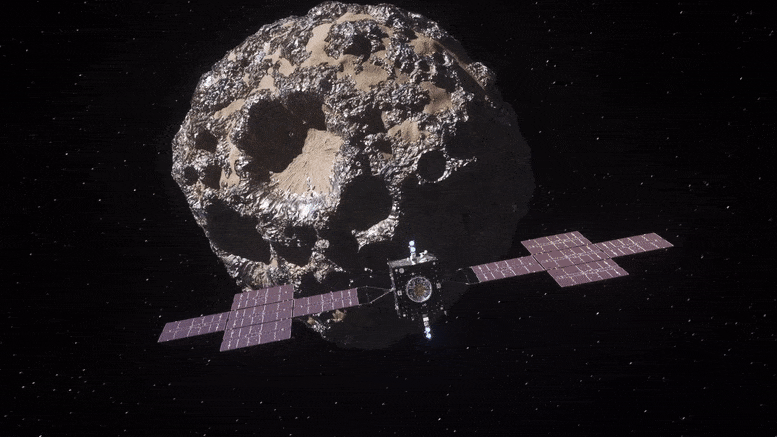
La missione Psyche della NASA esplorerà un asteroide metallico unico in orbita attorno al sole tra Marte e Giove. L’asteroide, che è probabilmente fatto in gran parte di metallo nichel-ferro mescolato con roccia, potrebbe contenere metallo dal nucleo di un pianeta minore (l’elemento costitutivo di un pianeta roccioso primordiale) e potrebbe fornire una finestra unica sulla violenta storia di collisioni e accrescimento che ha portato a pianeti terrestri come la Terra. credito: NASA
Il team della missione continua a completare i test del programma di volo del veicolo spaziale in preparazione per la data di lancio nel 2023.
Venerdì 29 ottobre[{” attribute=””>NASA announced that the agency decided its Psyche mission will go forward, targeting a launch period opening on October 10, 2023.
Psyche missed its planned 2022 launch period earlier this year as a result of mission development problems, leading to an internal review of whether the mission would be able to overcome these issues to successfully launch in 2023.
This continuation/termination review was informed by a project-proposed mission replan and a separate independent review, commissioned in June by NASA and the agency’s Jet Propulsion Laboratory (JPL) in Southern California, that investigated causes for the delay.
“I appreciate the hard work of the independent review board and the JPL-led team toward mission success,” said Thomas Zurbuchen, associate administrator of NASA’s Science Mission Directorate in Washington. “The lessons learned from Psyche will be implemented across our entire mission portfolio. I am excited about the science insights Psyche will provide during its lifetime and its promise to contribute to our understanding of our own planet’s core.”

This artist’s concept, updated as of June 2020, depicts NASA’s Psyche spacecraft. Credit: NASA/JPL-Caltech/ASU
The independent review board is still finalizing its report, which, along with NASA’s response, will be shared publicly once complete.
In preparation for the 2023 launch date, the mission team continues to complete testing of the spacecraft’s flight software. The new flight profile is similar to the one originally planned for August 2022, using a Mars gravity assist in 2026 to send the spacecraft on its way to the asteroid Psyche. With an October 2023 launch date, the Psyche spacecraft will arrive at the metal-rich asteroid in August 2029.
“I’m extremely proud of the Psyche team,” said JPL Director Laurie Leshin. “During this review, they have demonstrated significant progress already made toward the future launch date. I am confident in the plan moving forward and excited by the unique and important science this mission will return.”
NASA selected Psyche in 2017 to investigate a previously unexplored metal-rich asteroid of the same name. It is part of the agency’s Discovery Program, a line of low-cost, competitive missions led by a single principal investigator.
La NASA continua a valutare le sue opzioni doppia faccia Una missione per esplorare i sistemi binari di asteroidi binari, che originariamente dovevano essere lanciati sullo stesso sistema[{” attribute=””>SpaceX Falcon Heavy rocket as Psyche. NASA’s Deep Space Optical Communications technology demonstration, testing high-data-rate laser communications, is integrated into the Psyche spacecraft and will continue as planned on the new launch date.
The Psyche mission is a journey to a unique metal asteroid orbiting the Sun between Mars and Jupiter. What makes the asteroid Psyche unique is that it appears to be the exposed nickel-iron core of an early planet, one of the building blocks of our solar system.
Deep within rocky, terrestrial planets – including Earth – scientists infer the presence of metallic cores, but these lie unreachably far below the planets’ rocky mantles and crusts. Because we cannot see or measure Earth’s core directly, Psyche offers a unique window into the violent history of collisions and accretion that created terrestrial planets.
Arizona State University leads the Psyche mission. JPL, which is managed for NASA by the California Institute of Technology (Caltech) in Pasadena, California, is responsible for the mission’s overall management, system engineering, integration and test, and mission operations. Maxar Technologies in Palo Alto, California, is providing the high-power solar electric propulsion spacecraft chassis. NASA’s Launch Services Program, based at the agency’s Kennedy Space Center in Florida, is managing the launch. Psyche is part of NASA’s Discovery Program, managed by the agency’s Marshall Space Flight Center in Huntsville, Alabama.

“Giocatore. Aspirante evangelista della birra. Professionista della cultura pop. Amante dei viaggi. Sostenitore dei social media.”
